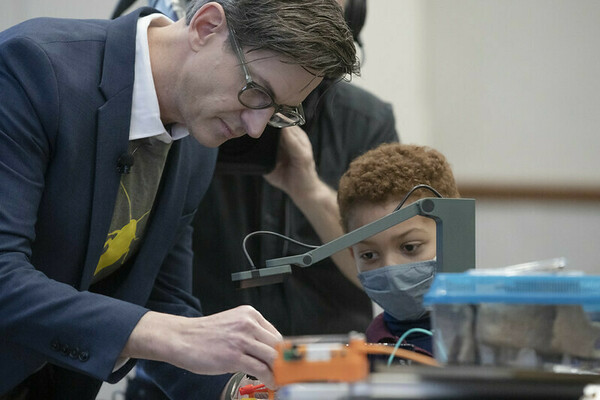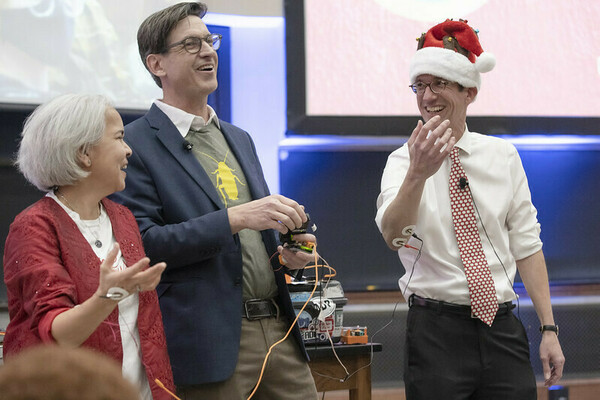
Giant cockroaches in a jar and ice water in a bowl. Check. Something called a SpikerBox. Check.
A University provost who can control the arm of a dean via electrodes. Ch–
Wait a second. What?
The inaugural Christmas Lecture hosted by the College of Science on December 9 was an interactive celebration of brains and neurons. Greg Gage, co-founder and CEO of Backyard Brains, used the company’s SpikerBox invention to demonstrate the fascinating field of “electrophysiology."
As a graduate student in biomedical engineering with a focus on neuroscience, Gage leaned upon his background as a former electrical engineer to develop tools that demonstrate to middle school students through adults how the brain functions. His novel methods include hooking up wires to severed cockroach legs (they will twitch!), exhibiting Venus flytraps that can count how many times “hairs” in their “mouths” are triggered by potential prey before they close (Feed me, Seymour!), and sharing numerous other experiments that simultaneously entertain and educate.
“I really enjoy the idea of engaging the public with advanced neuroscience topics,” said Gage, who also works as an adjunct professor at the University of Michigan. “When you can demonstrate hands-on in front of a live audience how the brain works, you can begin to pull back the curtains on something that at first seems quite mysterious. My goal is to get more people to realize that the brain can be studied and understood… and perhaps encourage others to join the cause.”

Santiago Schnell, the William K. Warren Family Foundation Dean of the College of Science, invited Gage to speak at the inaugural lecture – an event he anticipates will become an annual gift of science to the community.
He knew that Gage, a senior Fellow at TED and the recipient of the White House Champion of Change Award from former President Barack Obama for his commitment to citizen science, had a unique blend of skills. Gage engaged not only the community during the evening lecture, but also South Bend middle school students during a daytime talk. Additionally, he also spent a portion of a day with Notre Dame neuroscience students during a series of special sessions, which Nancy Michael, associate teaching professor in the neuroscience and behavior major, helped organize.
Schnell adapted the Christmas Lecture idea from a nearly 200-year-old tradition in the United Kingdom. Started by Michael Faraday, the inventor of the electric motor, the Christmas Lectures series is now broadcast on television in Great Britain and is highly anticipated each holiday season. The lectures aim to spark scientific curiosity in people of all ages – but particularly in children. Faraday himself gave 19 of the early Christmas Lecture talks, many on the chemical history of the candle.
“For two centuries, the Royal Institution Christmas Lectures have communicated science to the general public. Anyone fortunate enough to attend a Christmas Lecture knows that the lecturer needs to follow Faraday’s principle of taking nothing for granted as known,” Schnell said. “According to Faraday, the secret of a successful lecturer is ‘to inform the eye at the same time as you address the ear’.
“Greg is the epitome of Faraday's principle; this is why we selected him as the inaugural speaker for the Christmas Lecture at Notre Dame. Everyone in the audience had the opportunity to experience neuroscience with their eyes and ears!”
Gage, who earned his doctorate from Michigan, created touchscreens when he worked as an electrical engineer and became interested in citizen science, especially for young people, during graduate school.
“Talking to fifth graders about the brain was great,” said Gage. “But the experiments we were doing in our University lab were so much cooler. You can hear and see how the brain actually worked! That got us to thinking… wouldn’t it be great if we could invent something that allowed us to bring our expensive and delicate rigs into a school classroom? And with that idea… the SpikerBox was born!”
During the lecture in Jordan Hall, Gage invited audience members to participate in a couple of different experiments. While most of the volunteers were children or adolescents (including one girl who was squeamish about dropping two cockroaches in ice water to anesthetize them, and other children who were more enthusiastic about jumping, severed cockroach legs) the final experiment was demonstrated by Schnell and Marie Lynn Miranda, the Charles and Jill Fischer Provost of the University of Notre Dame.
Using the Spikerbox to provide the electrical current, Gage hooked an electrode up to Miranda’s right arm. He then connected it with a wire to an electrode on Schnell’s right arm. When Miranda flexed, Schnell’s arm flexed with hers.
Schnell jumped and laughed in surprise, and Miranda appeared gleeful as she continued to move her arm to elicit humorous reactions from him.
The audience responded with an equal amount of glee, proving that demonstrations of brain activity – a process which we normally cannot see – are the perfect educational tools to teach neuroscience.